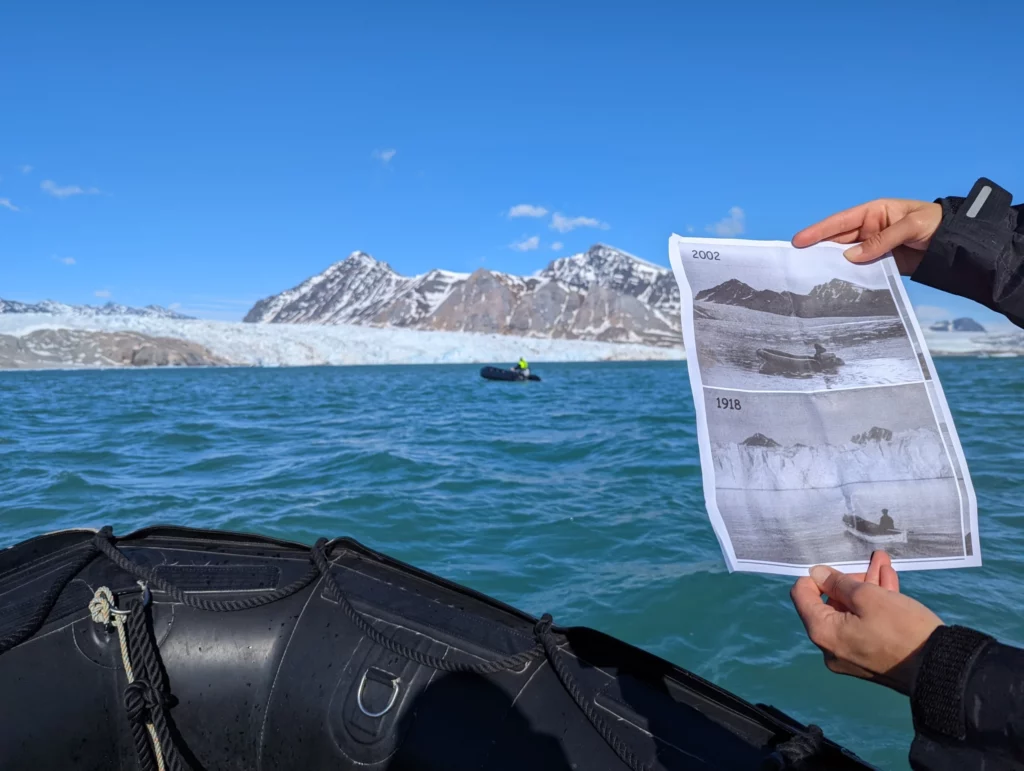
In 1918, researchers from the Norwegian Polar Institute reached the then mighty Blomstrand Glacier, in Svalbard, Norway, and snapped an epic picture showing a massive wall of ice hugging the nearby mountains, with only peaks showing as if they were standing on their toes to be seen. Fast-forward a century and the landscape looks radically different. Photographer Neill Drake went to the very spot where the original photo was taken and used the same angle to make a thought-provoking side-by-side comparison, showing the devastating toll global warming is taking on Arctic glaciers.
The picture was taken at virtually the same time of the year as the original shot, during Arctic summertime. This is plainly verifiable because the sun is always above the horizon at the North Pole during summer, circling the Pole once every day providing full sunlight all day long. Besides that, reaching this particular spot is impossible during any other time of the year because the icy fjords used to travel by boat there only thaw during the summer.
Drake took dozens of shots that day, then set out to find the best photo that matched the low opacity of the original. The end result is an almost perfect 1-to-1 reconstruction in terms of angle, lighting, and camera lens.
“There was a very distinct feature in all the photos that helped us line it up the best,” Drake told Newsweek. “There’s a wishbone shape of snow on the right mountain peak which I had noticed in the photos before we launched our small boat. That was my visual cue to know we were close to being in the same position. Due to the features of the peaks, parts of the wishbone would be hidden or wouldn’t appear the same. Then it just became a matter of getting both boats in the right position to most closely resemble the originals.”

But this isn’t the first reconstruction of the Blomstrand glacier. Swedish photojournalist Christian Åslund followed in the footsteps of daring explorers from the turn of the last century and recreated many daring old photos he found in archives, including the iconic picture of the lonely boat dwarfed by the once huge glacier.
This wasn’t Drake’s first incursion to the poles, though. He used to work as a guide in Antarctica, where he fell in love with the place and soon became involved in expeditions meant to promote the conservation of the icy continent and its wildlife.
“I use my photography as a way to show the beauty of this amazing place and help people understand why it’s worth protecting. I try to abolish the ‘out of sight, out of mind’ mentality. The more I show how beautiful and pristine Antarctica is, maybe people will consider visiting themselves,” Drake told PetaPixel.
His time as a guide at the South Pole also opened his eyes to the devastating effects of a warming climate. Drake first visited the Martial Glacier in Ushuaia, Argentina, also known as the southernmost town in the world, in 2016. Now it’s almost completely gone. However, for him, the side-by-side comparison of the two Blomstrand Glacier photos is perhaps even more dramatic.
The Arctic is warming at twice the rate of the global average due to carbon emissions that heat up the atmosphere. Arctic sea ice reaches its minimum every September, and that ice extent is now declining at a rate of 13% per decade relative to the 1980-2010 average.

Over the past 30 years, the oldest and thickest ice in the Arctic has declined by a stunning 95%. Since the satellite record began in 1978, the yearly minimum Arctic sea ice extent in September has declined by about 40%.
Both the Arctic and the Antarctic can be envisioned as the world’s refrigerators, helping to cool the globe’s energy system and balance out other parts of the world that absorb a lot of heat, such as the world’s oceans. Since they are largely covered by snow, which is mostly white, much of the incoming sunlight is reflected back into space. If ice at the poles melts, that reflected solar energy would then stay in the planet’s weather system, driving more extreme weather, such as powerful storms, floods, and heatwaves.
One obvious consequence of a melting Arctic is rising sea levels. Since about the time the original Blomstrand Glacier photo was taken, the global average sea level rose by about 7.5 inches (19 cm) and it’s only getting worse.
Follow Neill Drake on his website and Instagram.






